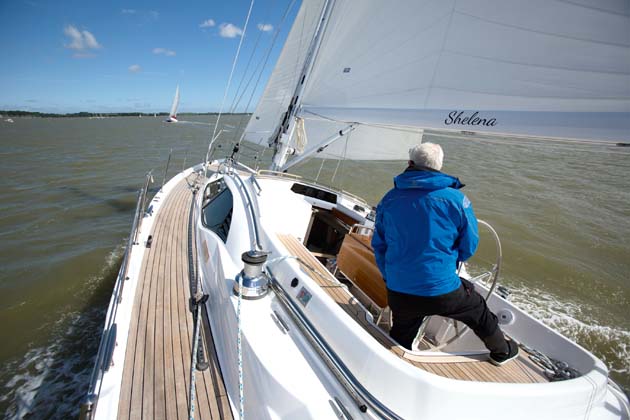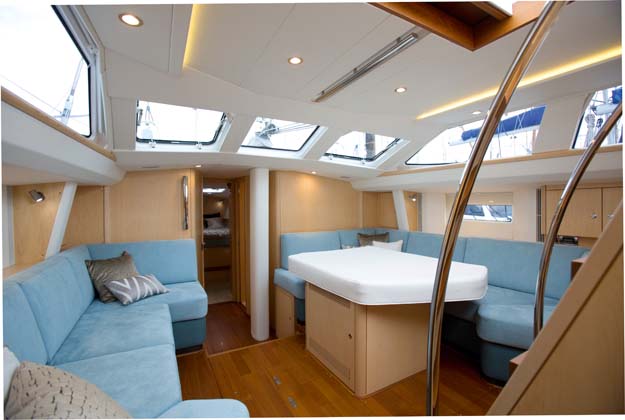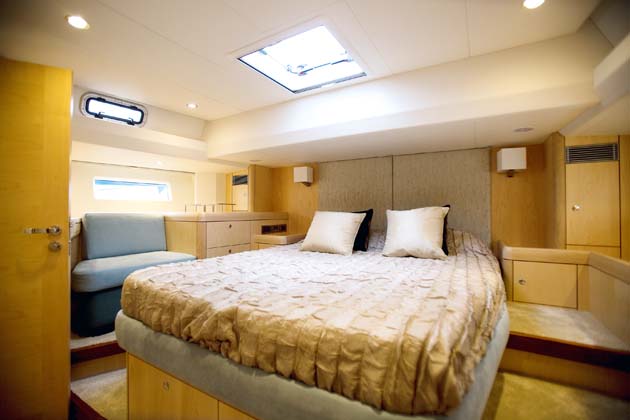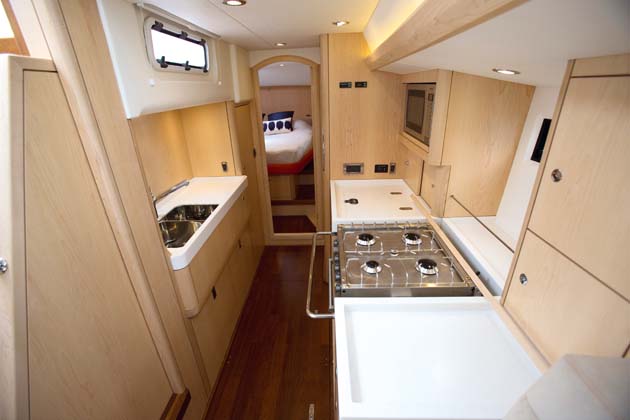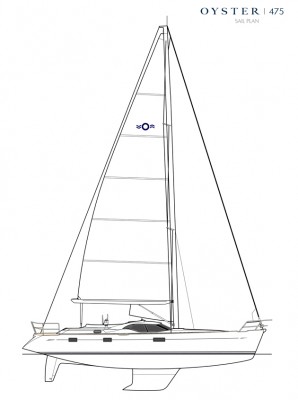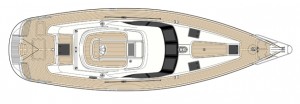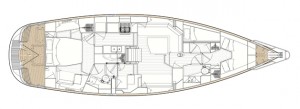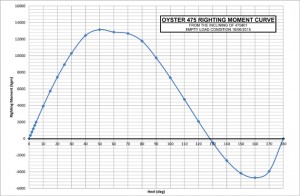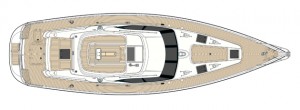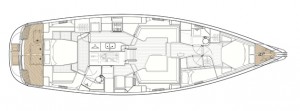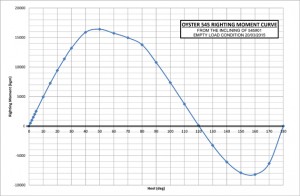Oyster has breathed on two of their most popular boats, but are they better than the original versions? Matthew Sheahan finds out
Oyster 475 and 545 boat test – two polished Oysters
Creating a second great album, bestselling book or blockbuster film can be far harder than the first. Boats and cars are no different, but there are some that have succeeded in following their initial successes through subtle refinement rather than redesign.
Among the motoring examples, BMW has stuck religiously to its trademark double-grilled front and refused for years to create a hatchback design – until recently, the company offered just two simple choices, a saloon or an estate.
Continuing the car theme, Land Rover has also stuck to its guns, producing a range of chunky four wheel drive vehicles capable of handling everything from steep off-road ascents and deep river crossings to treacherous puddles in supermarket car parks. They too have refined their models with each iteration, but have been so successful at pimping their own rides that models such as the Discovery and Range Rover converged on each other, forcing a complete rethink of their range.
The latter example is a pertinent one when it comes to some of Oyster’s more recent launches. Clearly this 42-year-old company is not trying to creating a ‘second bestseller’, they’ve had plenty of those and are much further down the track. But the company has spent time considering how to continue its success and whether this would require a complete rethink of its range or merely a reworking of successful models. The motor industry was one of a number of avenues the company studied in order to find the solution.
The Land Rover of bluewater sailing
“Over the years we’ve thought long and hard about which car manufacturer most represents Oyster,” says managing director David Tydeman. “Given that the underlying theme in our range is about go-anywhere boats, it’s Land Rover that is closest to what we do for bluewater sailing.”
Few would argue with that. A range spanning 48-125ft LOA provides a wide variety of routes to achieve the same goal: long-distance, luxury cruising. Yet among the nine current models, two stand out for their links to former popular models.
The Oyster 46 was first launched ten years ago and sold 29 boats. Now the company has stretched and relaunched the model as the new 475, a boat that is 18in longer. At 49ft LOA she would be a large cruiser for many, but in this company she’s the baby of the fleet.
The second is the Oyster 545, a reworking of the popular 54, which was first built in New Zealand in 2008 before the tools were shipped back to the UK. Fourteen had been built Down Under under licence by McDell Marine and by the time the refresh started a total of 21 Oyster 54s had been launched.
Unlike the 475, the new, breathed-on 54-footer remains the same length and the changes are much subtler. Even so, Oyster has already sold nine of the new versions.
So how are both boats different from their previous incarnations and what’s the fresh appeal?
Oyster 545
With the 545 you have to look very closely indeed to spot the difference from the outside as the only obvious clue is her hull portlights. Unlike the new style aboard the larger boats with their vertically set rectangular portlights, the 54’s still lie horizontally; they’re just bigger.
Nothing else has changed on deck. She still has a cockpit that can comfortably seat five when under sail. She still has a sail plan that can be handled manually, but can easily cater for full-powered options if required. And best of all, she still has powerful beamy sections aft that make her a superb and quick passagemaking machine, especially reaching.
She’s a dry boat too and yet the freeboard, though high, isn’t intimidating and you can easily jump down to the pontoon without a parachute and climb up without a set of steps.
There is good visibility from the single helm position and plenty of space to arrange deck controls back in the cockpit as you prefer.
Admittedly I am biased, having sailed my friend’s 54, Raiatea, a great deal over the past few years and she has proved to be an excellent cruiser for two to six people.
Below decks is where the biggest changes have been made, but even then most of the obvious ones are with styling rather than layout. We sailed boat no 1, which displayed a bold, vibrant approach with maple joiner work and sky blue Alcantara upholstery that looked modern and fresh, almost clinical.
But there were subtle changes elsewhere. The headliner is no longer a glassfibre moulding, but conventional material-clad panels. Under the companionway is a wet locker, more accessible than ours, which is down in the galley, but still small. The navigation station has been raised slightly to make this part of the boat more inclusive with the saloon. There is a freezer opposite the fridge where our wet locker is and the companionway steps are boxed in.
And that’s it, the key differences in a nutshell, hardly the reason to cash in your current 54 for the this latest version. But that’s not why the new boat is selling.
The first reason is that it’s a comfortable size for an owner/skipper, well mannered and spacious. But Oyster has created additional appeal by changing its approach to customising boats.
Until recently, choosing from a list of predetermined extras – albeit a very long list – was pretty much the limit of the changes you could ask for as an owner. Today the company is happy to talk about far bigger alterations to the standard spec, which might include such fundamental changes as moving bulkheads, extending decks, spade rudders, carbon rigs and full-width chainplate bases.
This will be music to many people’s ears, especially as the 54, now 545, strikes a clever balance. She’s big enough to have long legs offshore and a comfortable ride for crossing oceans while being small enough (just) to wriggle over the sills in North Brittany harbours and into their snug marinas.
Add elegant, well-proportioned looks to this comfortable, powerful and manageable cruiser, and a new approach of creating more options for a well proven, versatile boat and I’m not at all surprised she’s doing well. But as I say, I’m biased.
Oyster 545 saloon
Sky blue Alcantara and maple joiner work and larger hull ports make for a bright, modern interior. Subtle changes such as raising the navigation station sole and reducing shelf height give a spacious feel
Oyster 545 galley
Again, the layout remains the same, but details such as a shelf for glasses and cups and a large upright freezer, rather than a top entry type, makes useful refinements to an already well thought-out galley
Oyster 545 aft cabin
Other than in styling, the sleeping cabins have changed the least, although Oyster’s new approach means that you could make bigger changes than was previously possible under the normal spec
Oyster 475
From a distance, you’d be hard pressed to tell this boat apart from the 545. She carries the same modest, yet elegant hull shape and sleek contemporary styling on deck. Her cockpit looks very much the same and as for her sail plan you will only notice a difference if you look right at the top of the rig where the forestay comes in just slightly below the masthead.
A more obvious clue for fanatical boat spotters is the number of portlights – just three in the hull and one in the coachroof, two less in total on each side than the 545.
But this boat differs more significantly from her original incarnation than the 545. She’s 1ft 6in longer for starters and while that has allowed her stowage and deck layout to breathe a little more in some areas, the big difference comes in her new-found performance.
The 46 was always a good boat, as proven by the number sold, but the extra waterline length clearly suits the 475; she’s a lovely boat under sail. In fact, I’ll go further. She’s even more fun to sail than the 545, which is a boat I believe has plenty to recommend her when it comes to performance.
Light on the helm, responsive, quick and best of all nimble, the 475 did a good job keeping pace with the 545 when we sailed them side by side for our photo shoot. Clearly, as her waterline length and sail area ratios confirm, the 545 is going to have the legs on her smaller sister offshore, but it is the ease of handling aboard the 475 that stands out.
What the 475 lacks in straight line speed she makes up for in feel. In the gusty conditions on the River Orwell her helm was never overloaded and you could always steer her out of a big gust. Such good, balanced behaviour with a sail plan that is considerably smaller and therefore easier to manage than the 545’s makes her a great boat for a couple. She has recently been nominated for European Yacht of the Year.
There are no lines or loads that can’t be handled manually and yet she’s still big enough to accommodate powered winches and systems if required. Even a simple detail such as the slightly lower boom height made her that bit easier when it came to dropping and stowing the main.
Below the waterline she draws 2.16m (7ft 1in), which provides a greater margin when exploring shallow anchorages and accessing snug harbours.
The only area I wasn’t so keen on was her handling under power where her sail drive provided no prop walk and therefore left me with little choice but to use the bow thruster to work her into small gaps. My preference would be to have a shaft-driven prop along with the wiring for a bow thruster in case it’s absolutely required. (My experience with a friend’s previous boat, a 47, was that with this configuration the thruster simply wasn’t needed and we never fitted one.)
Apart from that she has a decent-sized cockpit with plenty of space to lay out the controls to suit your sailing.
Our test boat had a slab reeling mainsail, which made the best of her sail plan. Personally, I wouldn’t consider anything else on a boat of this size as the compromise in performance with an in-mast furling mainsail is too great for a boat that is easily managed without.
Below decks she’s a Tardis and you have to look closely to see where the areas are that make her smaller than the 545 because on the face of it she looks the same. Only when you line the two up side by side do you see how she’s a more compact version.
Our test boat was also the first of the new range and her owner had gone for tan Alcantara and maple joiner work to achieve another fresh modern look.
Throughout her accommodation the standard of build is every bit as good as you’d get on a model at the top of the Oyster range, one of the reasons that she has such a healthy price tag.
But one word of advice for those warming to the idea of this excellent sub 50ft bluewater cruiser: be sparing with the amount of kit that you add on. Overloading her with all the toys is going to compromise her best quality: her performance. So while Oyster probably won’t thank me for saying this, go easy on the extras.
Oyster 475 saloon
The 475 may be 18in longer than her predecessor, but the saloon remains the same size. She does benefit from a fresh modern style
Oyster 475 aft cabin
The double cabin aft provides yet another example of how the accommodation has been lifted throughout this boat with the lighter upholstery and maple joiner work
Oyster 475 galley
This area may be smaller than the 545’s, but the longitudinal galley remains a very practical area of the boat, deep in the hull and with good security even when the going gets lively
Specifications
Oyster 475
LOA 14.81m/48ft 7in
LWL 12.36m/40ft 7in
Beam 4.41m/14ft 6in
Draught 2.16m/7ft 1in
Displacement 16,000kg/35,273lb
Engine Yanmar 4JH4-TE 75hp
Fuel 750lt/165gal
Water 650lt/143gal
Sail area 150% foretriangle 120.1m2/1,293ft2
Sail area:disp 17.65
Disp:LWL 258
Price ex VAT £690,000
Designed by Rob Humphreys
Oyster 545
LOA 16.43m/53ft 11in
LWL 14.10m/46ft 3in
Beam 4.75m/15ft 7in
Draught 2.40m/7ft 10in
Displacement 21,315kg/46,893lb
Engine Yanmar 4JH4-HTBE 110hp
Fuel 850lt/187gal
Water 750lt/165gal
Sail area 150% foretriangle 154.09m2/1,658ft2
Sail area:disp 19.80
Disp:LWL 211
Price ex VAT £925,000
Designed by Rob Humphreys
Conclusion
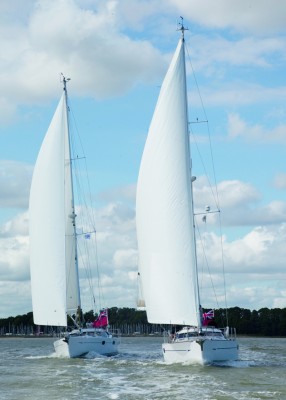 Given the general appetite for bigger, more voluminous boats, it is interesting to see two successful models that not only prove that bigger isn’t necessarily better, but also demonstrate how refinement rather than redesign can be the answer.
Given the general appetite for bigger, more voluminous boats, it is interesting to see two successful models that not only prove that bigger isn’t necessarily better, but also demonstrate how refinement rather than redesign can be the answer.
Both are good-looking cruisers that have already demonstrated how they have remained appealing and modern while fitting in with Oyster’s contemporary look.
As for choosing between the two, naturally cost will play a big part as will the type of sailing you have in mind. They both have healthy price tags, but if you know what you want within an already proven design, now is a good time to create the Oyster you’d like.
And while it’s unlikely that many will be comparing a 475 against a 545, for what it’s worth if I had to make the choice I’d be heavily swayed in favour of the 475. In my opinion, she’s one of the best boats the company has built in years.
But more than anything else, both boats demonstrate that sometimes the best way forward is to start by changing very little.





